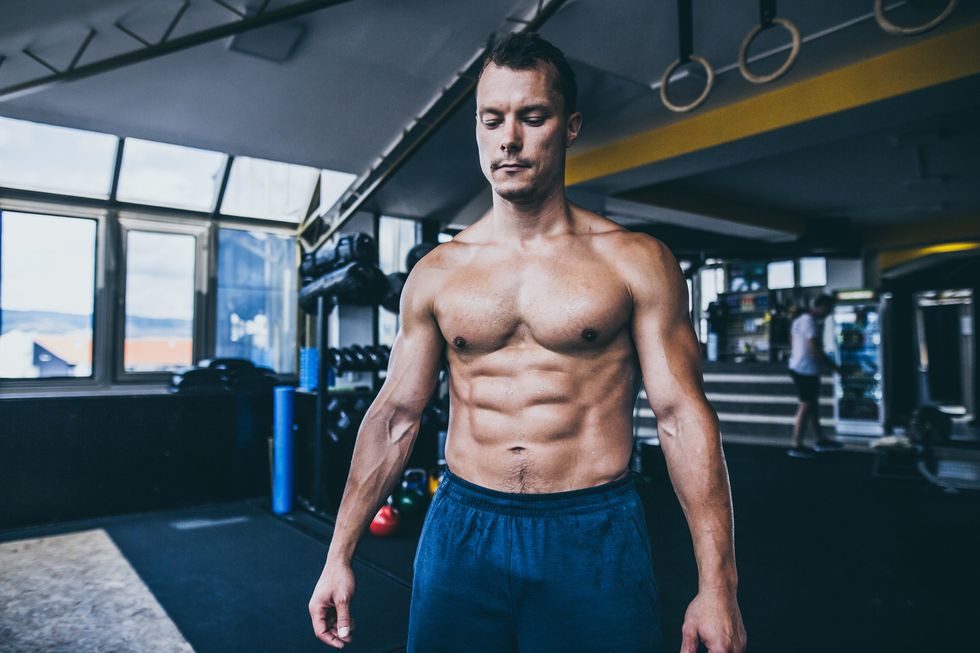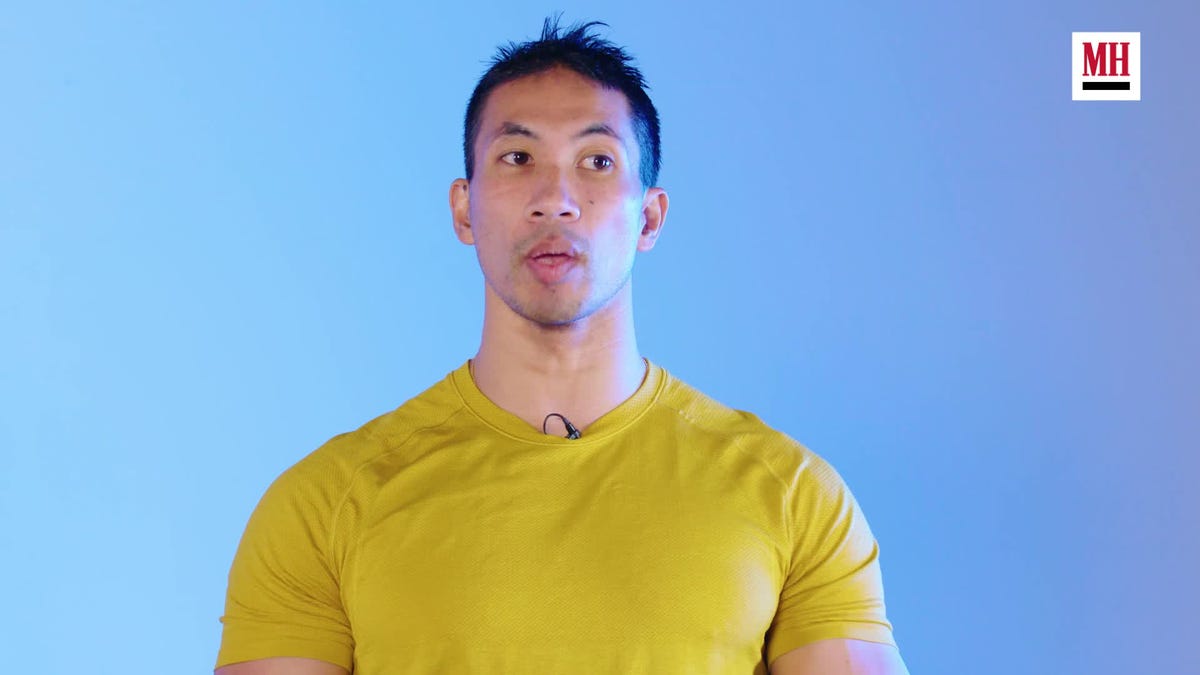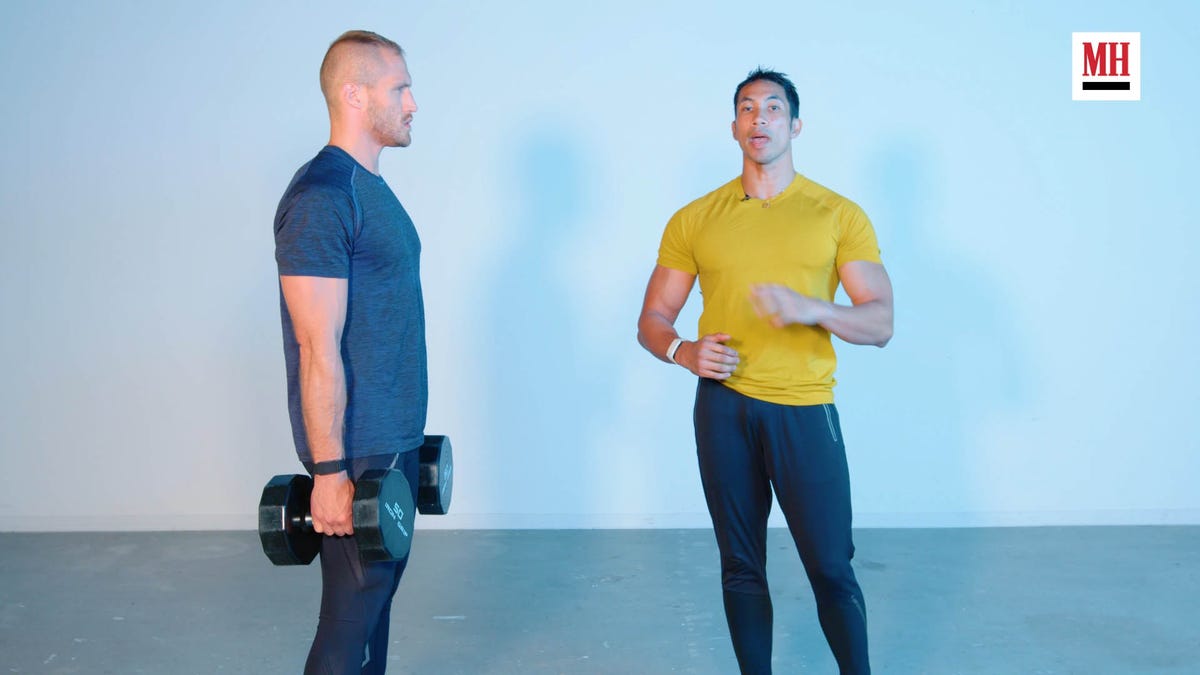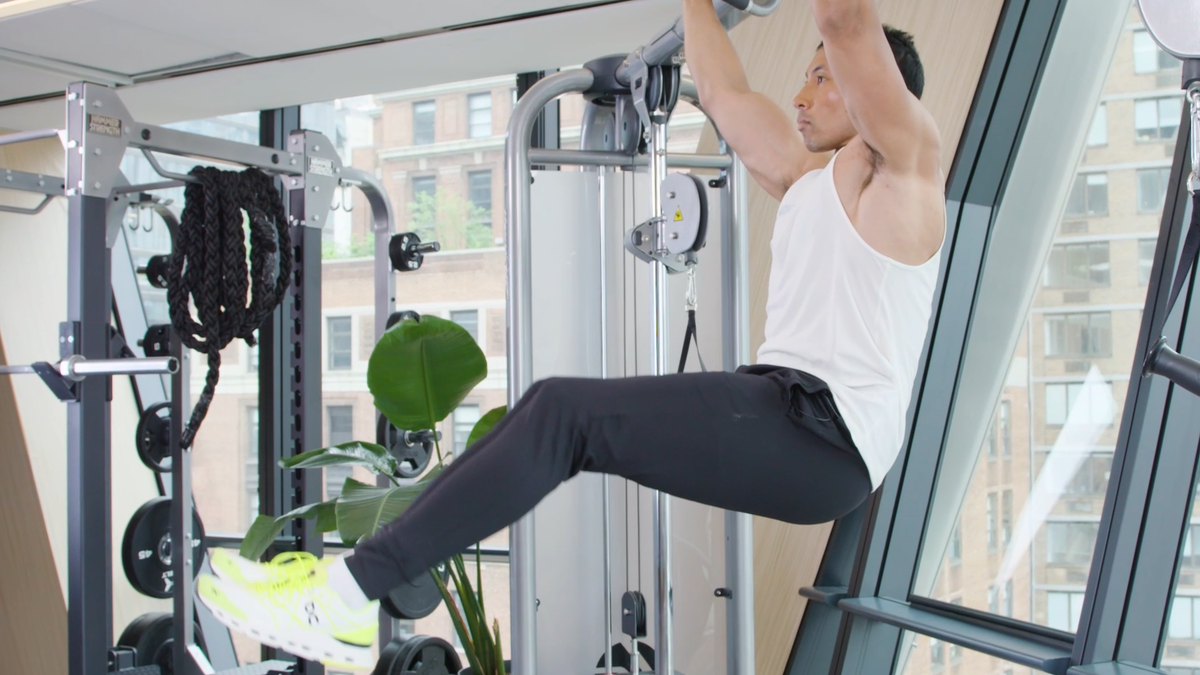YOU CAN GET a home gym delivered to you overnight, a lavish spread from your favorite Greek spot in an hour, and dial up a blockbuster film in less than a second. But in a world where you can get everything almost instantly, a chiseled midsection worthy of a movie poster (or a cover of Men’s Health) still takes time.
Exactly how much time depends on where you’re starting, says Kurt Ellis, C.S.C.S., owner of Beyond Numbers Performance. And there’s less to do with the number of crunches you can string together than with how lean you are—which has to do with the amount of body fat you carry and your body’s unique anatomy.
“Ten percent body fat is, usually, where you’re going to physically see the abs,” he says. So the closer or further away you are from that number, the time for your abs to pop may be different. “It’s going to depend on a number of factors. But the one thing that needs to coincide are the diet and nutrition habits that you have.”
How Long Does It Take to Get to Abs?
Depending on your starting level of leanness, getting those habits in order can result in visible abs in as little as 30 days, Ellis says. But carving out a six-pack in just four weeks is not easy, and the results may not be as long-lasting or as effective for your long-term fitness as taking more time, says Men’s Health fitness director Ebenezer Samuel, C.S.C.S.
“Maybe you get to that point, but it’s only for a moment… and then you never have [visible abs] again or never train that hard again,” he says. But if you get lean over time in a way you can sustain, “you’re going to have more muscle. You’re going to feel better. You’re toting around less weight, so you can move faster and more athletically. You’re going to be healthier.”
Here, Ellis and Samuel explain the dos and don’ts of getting to that sought-after 10 percent goal, and provide their favorite moves for building a functional midsection built for both looks and performance.
What to Do—and What Not to—to Get Your Abs to Show
Both Samuel and Ellis agree that the biggest mistake men make when pursuing visible abs is chasing instant gratification. “If you rush it, you’re not doing something that’s sustainable that can become a lifestyle,” Samuel says. So you’ve got a six-pack for six days or six weeks instead of a lifetime of good, sustainable fitness.
That also sacrifices what Ellis says is the main benefit of pursuing a shredded core: The habits you develop along the way. “Whether it’s incorporating better sleep, controlling the nutrition portion of things, or consuming more water,” he says, “it’s worth it because it helps you create good habits.”
Here are some of the habits the experts say you should aim to develop—and others that are an error keeping your abs under wraps.
How Diet Affects Abs
Don’t: Try to Get There With Training Alone
There’s a reason people say that “abs are made in the kitchen,” Ellis says. “A lot of guys fall into the trap of ‘I could just work out my way into abs,’ and not make nutritional changes.”
The science doesn’t back that up: When researchers compared the effects of different types of training on fat loss in a 2021 analysis of 56 studies, they found that different types of cardio training had similar impacts on fat loss. They also discovered that the amounts of fat lost due to the cardio itself weren’t that significant when done alone without dietary intervention: People who add in more training often wind up eating more calories, too, sabotaging some of their results.
Do This Instead: Develop Diet and Exercise Habits That Will Make You Leaner
One of the reasons Ellis thinks gunning for visible abs is a worthwhile goal to pursue is that it can help you develop nutritional and training habits that will serve your health and athleticism in the long term. So instead of going all-in on one approach—all training, for example—try to dial in some smaller habits that serve your six-pack goal in the short term, and then the goals you’ll have afterward.
“Be very consistent and very deliberate with what you’re doing from a nutritional perspective, a recovery perspective, and a training perspective,” he says. Eating more protein, adding in more vegetables, consuming healthy fats: All of these adjustments contribute to melting fat in your midsection, but also make it easier to keep your hard-earned abs. “You want to create sustainable habits in order to maintain that physique, and to maintain those abs that you’re working for.”
Don’t: Cut Every Single Carb
While your diet is the main driver of getting lean, a diet that reveals abs isn’t one that completely ditches carbs.
“There is this perception that to get visible abs, you need to eat only chicken and broccoli, and if you do anything else, you’re going to fail,” Samuel says. “But your diet does not need to be flawless to get to eight to 12 percent body fat. You need to up your protein, drink more water, and generally eat healthy.”
Depending on your lifestyle and workout schedule, Ellis says, limiting carbs too much can be counterproductive. You may add more cardio training on top of your resistance work to reduce body fat, and you may try to train harder than in the past. Doing that, Ellis says, requires carbs to fuel your work.
Do This Instead: Prioritize Protein Intake
Your goal is to not just to burn fat, but to maintain—and even build—lean muscle tissue. So while cutting carbs can help, ramping up your protein intake is essential.
“That’s the thing to look out for the most: Making sure you’re sticking with the typical recommendation of one gram or more per kilogram of bodyweight,” Ellis says. The rest of your diet should be a mix of carbs and healthy fats that keep you in a caloric deficit.
One gram of protein per kilogram of bodyweight is less than the number of “one gram per pound of body weight” that’s often tossed around in locker rooms and forums. Some studies, like this one from 2011, have suggested you can go even higher. The researchers found that, depending on the subject’s caloric deficit, consuming as much as 1.8 to 2 grams per kilogram of bodyweight per day might help to prevent loss of lean mass “during periods of energy restriction to promote fat loss.” Make sure to consume as much of that as possible from real food sources, then supplement accordingly to hit your target.
How Your Workouts Effect Your Abs
Don’t: Just Do Tons of Cardio
“We all hear, especially nowadays, that cardio is the most ideal way of shedding fat fast,” says Ellis. And that extra cardio time sacrifices strength training time. In the meta-analysis of fat loss studies from 2021 discussed above, some subjects were able to lose significant fat simply by doing more cardio, but they had to do a lot—an extra 100 minutes per day.
This “cardio or bust” strategy is wrong for multiple reasons, Samuel says. “The first is that if you think about your body fat as a percentage, that works from both sides,” he says. “If you build muscle, but your body stays the same weight, then your body fat percentage has gone down.”
More muscle also means more calories burned in general, Samuel says. When you have more lean mass, your body’s base level of calorie and fat burn goes up. The other reason a cardio-focused strategy isn’t ideal is because it doesn’t challenge the core itself enough.
“So you never build the visible muscle that helps make for a really nice set of visible abs,” Samuel says.
Do This Instead: Combine Strength Training and Cardio
Guys tend to go to one extreme or another with their training strategies to get lean, Ellis says.
“Either ‘I’m going to incorporate a ton of cardio, because that’s the best way to lose fat,’ or ‘I’m just going to do resistance training,’” he says. While you might dial up some extra cardio, don’t allow it to sap your strength work. “A combination of both is the best way to shed fat and maintain lean muscle. Avoid the all or nothing mindset.”
Don’t: Just Do Lots of Direct Ab Work
When you’ve lost enough fat to reveal your abs, you still need muscle to show. So building the rectus abdominis—the “six-pack muscle”—is important. But that doesn’t mean you should do thousands of crunches, Ellis says.
“I’m not against crunches at all. I think they get a bad name,” he says. But focusing too much on training the rectus abdominis takes time and energy away from other lifts: “What are you sacrificing for that? Having a diverse approach to core training is the way to go.”
And while you’ll want to train those core muscles you want to show when you shed your shirt to build muscle up, you can’t pick and choose where you burn fat. Doing exercises targeted at one specific spot on your body to reduce fat isn’t effective—“spot reduction,” as it’s called, isn’t actually possible. In other words, all of those crunches won’t be the direct reason you lose fat in your midsection, no matter how much your muscles feel like they’re burning.
Do: Mix Total-Body Resistance Moves with Functional Core Work
Performing compound lifts, like squats, deadlifts, and bench presses, will provide the mechanical overload that causes your body to burn fat. These moves also challenge your core to brace as you hold your spine straight, one of the functions of your core.
“To get that amazing core look takes more than just situps,” Samuel says. The rest of your ab work, he says, should focus on all the other functions of your core and trunk: Rotating, resisting rotation, spinal extension (like is done in a back extension), and spinal flexion, which is done when crunches or leg lifts.
Training all the functions of your core will make you a better, more well-rounded athlete. But it will also help you with the goal of visible abs.
“The aesthetic physique that we’ve always looked up to tends to be very, very functional,” Samuel continues. Developing your whole core means you’ll have abs that look how you want, but that will also help to protect your spine and promote healthy movement.
The Best Exercises for Your Abs
Hit all the sections and functions of your core to build a six-pack worth showing off: Add these five favorite core moves from Samuel and Ellis to your warmup, finisher, and everywhere in between.
Med Ball Lateral Toss
These don’t just work on the rotation of your core, but can make you a better athlete, Ellis says. “It’s a great way to work on coordinating the upper body and the lower body more fluidly, so you can better express your athleticism.”
How to Do It:
- Stand with a wall on your right side about 4 feet away, and the ball on your left hip, held with both hands.
- With knees slightly bent, twist through your torso to swing the ball around towards your right hip, releasing it so it flies against the wall around chest height.
- If it bounces back, catch the ball and rotate back to start. If not, pick it up and reset. Do 2 sets of 5 throws on each side.
Pallof Press
Your core rotates, but it also resists rotation, Ellis says. When an outside force tries to spin your spine—like an opponent grabbing a basketball, or a dog running to one side on its leash—your core keeps it static. This move helps train that ability.
How to Do It:
- Stand with your feet around hip-width apart in an athletic stance, with a cable stack at around chest level on your right.
- Pull the cable out and hold it against the front of your chest with both hands. The cable should be taut. Hold your core tight.
- Maintaining this body position, press the cable straight out away from your chest–the cable will try to rotate you towards the station. Resist this rotation. Return the handle to your chest, and repeat.
- Do all your reps on this side, then switch and repeat with the cable stack to your left.
Farmer’s Walks
Samuel says these challenge the core and burn calories at the same time. Loading the weight on one arm only—or performing variations where the weight is overhead or held out to the side—will provide an additional core challenge as you work to stay upright.
How to Do It:
- Grab a pair of dumbbells and stand with them at your sides, with your chest tall and shoulders back. Squeeze your glutes to shift your pelvis into neutral. Tighten your abs.
- Walk forward holding the dumbbells, maintaining this tall posture.
- Start by doing three to four walks of 20 feet or 20 to 30 seconds. Put the dumbbells down to rest between each.
Speed Skaters
Plyometric moves like this, or lateral bounds, are “to an extent, a core movement,” Ellis says. This is because you need to brace each time you land. Skaters add an extra core challenge because you twist on each rep, and will feel your core contributing to your explosion to the next rep.
How to Do It:
- Stand with your weight on your right foot and your right knee bent. Lift your left leg off the floor behind you.
- Now bound to your left by pushing off with your right leg. Land on your left foot, lifting your right leg off the floor behind you.
- Continue hopping back and forth. If needed, touch your back foot on the floor behind you for balance.
Hanging Knee Raise
Spinal flexion, the movement you perform when you do a crunch, is one of the core’s functions. But hanging leg raises, or this easier version, tucking the knees, is a better way to train this function, Samuel says. You’re initiating the movement from the lower part of your core, which brings your legs up as you would in a sprint or another move—and also makes sure this section of the rectus abdominis gets trained.
As your body fat drops and your strength develops, work towards lifting straight legs, and ultimately bringing your toes all the way to the bar.
How to Do It:
- Hang from a bar with an overhand grip. Let your legs hang straight beneath you.
- Squeeze your shoulders, abs, and glutes so you don’t swing. Now raise your knees up until your thighs are parallel with the floor. Keep your torso straight and core braced throughout.
- Control your legs back down to start. Repeat.

Greg Presto is a fitness and sports reporter and videographer in Washington, DC.









Comments are closed.